| |
 |
 |
| |
| Cuban
Convertible Peso |
| |
The Convertible Peso
(sometimes given as CUC$ and informally called a CUC or a chavito) is one of
two official currencies in Cuba, the other being the Cuban peso. It has been
in limited use since 1994, when its value was pegged 1:1 to the United
States Dollar.
In 1981–1989 Cuba used so-called INTUR coins
and cheques. Convertible foreign currency was
exchanged into these cheques rather than the national currency, which could
be used to buy some luxury goods not available for purchase in the national
currency. Also, from 1985, Banco Nacional de Cuba issued foreign exchange
certificates of various types.
Because of the economic problems during the Special Period, the Cuban
government allowed the possession of U.S. Dollars (which had previously been
illegal) and began selling goods and services in U.S. Dollars, initially for
tourism and for luxury items. In 1994, they
began issuing the Convertible Peso, to circulate together with the U.S.
Dollar. This currency is separate from the
regular Cuban Peso (CUP), which was used for staple items. The Cuban Peso
(CUP) can be exchanged to the Convertible Peso (CUC) at exchange offices (CADECA)
at a fixed rate. Since the early 2000s the rates have been 24 CUP to 1 CUC
(sell) and 25 CUP to 1 CUC (buy); but for state bookkeeping purposes, both
pesos are valued at a 1:1 rate.
On 08 November 2004, the U.S. Dollar ceased (withdrew the U.S. dollar from
circulation) to be accepted in Cuban retail outlets, citing the need to
retaliate against further sanctions from the Helms–Burton Act After a grace
period ending on 14 November 14 2004, a 10% surcharge began to be imposed
when converting U.S. Dollars into Convertible Pesos. The change was
announced some weeks beforehand, and was extended by the grace period. It
has been claimed that it was because the amounts of U.S. Dollars being
exchanged were more than anticipated. The measure helped the Cuban
government collect hard currency Therefore this action left the Convertible
Peso as the only currency in circulation in many Cuban businesses.
Officially exchangeable only within the country, its value was increased to
US$1.08 in April 2005, but reverted to US$1.00 on 15 March 2011. The
convertible peso is, by the pegged rate, the twelfth-highest-valued currency
unit in the world and the highest-valued "peso" unit.
On 22 October 2013, it was announced that the currency is to be scrapped,
with it being gradually unified with the lower-value Cuban Peso, though as
of January 2020, that unification has not been achieved, nor has any target
date been officially announced. |
| |
| |
| Currency:
INTUR Peso = 100 centavos (visitor's coinage, 1981-1989). |
| In 1988 a coin set of 1,
5, 10 and 25 centavos (KM# 410, 413, 416 and 419 respectively) with simple
Reverse side (large Numerals in the center) design were produced, only to be
used by tourists from socialist countries. These type of coins were minted
at Mincovňa Kremnica (Kremnica Mint), Czechoslovakia (now in Slovakia). The
below listed design of coins produced during 1981-1989, were used by
tourists from western countries. All such coins with "INTUR" logo were
demonetized on 15 October 2001. |
| |
|
1981 |
| |
|
 |
Cuba
KM#412.2 / Schön# 706.2 5
Centavos. Year:
1981. Weight:
3.52g [3.50 g]. Metal:
Copper-Nickel.
Diameter:
19.50 mm.
Edge:
Plain. Alignment:
Medal. Mint:
Empresa Cubana de Acuñaciones, Havana, Cuba.
Type2: Thin Numeral "5"
at the center right side on the Reverse
side. |
Obverse:
"INSTITUTO NACIONAL DE TURISMO"
(National Institute of Tourism) written in Spanish in the top
section. Polymite (seashell) in the center.
"• 1981 • CUBA •" written at the bottom.
Reverse:
Logo of the National
Institute of Tourism ("INTUR") featuring a Real Palm tree in the center.
Numeral "5" written at the center right side. Value "CINCO
CENTAVOS" (Five Centavos) written at
the bottom.
Mintage:
N/A.
Minted Years:
One year
type.
- KM#412.1
Date: 1981.
Thick numeral "5" at the
center right side on the Reverse side.
- KM#412.2
Date: 1981.
Thin numeral "5" at the
center right side on the Reverse side.
- KM#412.3
Date: 1989.
Small numeral "5" at the
center right side on the Reverse side.
Polymita picta, common name
the Cuban land snail or the painted snail (different colours and
designs), is a species of large, air-breathing land snail, a
terrestrial pulmonate gastropod mollusk in the family
Helminthoglyptidae. This species is the type species of the genus
Polymita.
This snail is endemic to Cuba. These arboreal molluscs live mainly
in coastal habitats in the subtropical forest, with a preference for
certain tree species including Chrysobalanus icaco, Metopium
toxifera, Metopium brownei, Bursera simaruba and Coccoloba retusa.
Shells of Polymita picta can reach a length of about 20 millimetres
(0.79 in). These large shells are shiny and very brightly colored.
Normally they show a bright yellow color with a white stripe, but
the species is well known for its colourful shell polymorphism, with
numerous color varieties.
These shells are sought after by poachers and used to make jewelry
and trinkets. As a result, the species has become endangered. It is
a protected species since 1943 by the Cuban legislation which
prohibits the export except for scientific reasons.
Polymita picta mainly feeds on lichen, moss and on fungal biofilms
present on bark and leaves. The life cycle lasts about 15 months,
with breeding time during the wet season (September- October). The
snails become dormant in the dry season (December- beginning of
May).
Like most air-breathing land snails, Polymita picta has female and
male reproductive organs (hermaphroditic), it is unable to
self-fertilization. Moreover similarly to other gastropods in the
superfamily Helicoidea, this species uses love darts as part of its
mating behavior. During the courtship these snails spear the partner
with a calcareous dart. |
|
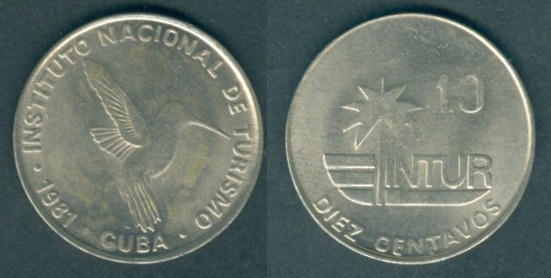 |
Cuba
KM#415.1 / Schön# 707.2 10
Centavos. Year:
1981. Weight:
3.96g [4.00 g]. Metal:
Copper-Nickel.
Diameter:
20.85 mm.
Edge:
Plain. Alignment:
Medal. Mint:
Empresa Cubana de Acuñaciones, Havana, Cuba.
Type: "CUBA" written at the
bottom on Obverse side. Large Numeral "10" (3.50 mm) at the center right side on the Reverse
side. |
|
Obverse:
"INSTITUTO NACIONAL DE TURISMO"
(National Institute of Tourism) written in Spanish in the top
section. The bee hummingbird in the center.
"• 1981 • CUBA •" written at the bottom left side.
Reverse:
Logo of the National
Institute of Tourism ("INTUR") featuring a Real Palm tree in the center.
Numerals "10" written at the center right side. Value "DIEZ
CENTAVOS" (Ten Centavos) written at
the bottom.
Mintage:
N/A.
Minted Years:
One year
type.
The bee hummingbird, zunzuncito, Zunzún or Helena
hummingbird (Mellisuga helenae) is a species of hummingbird which is
the world's smallest bird. It is endemic to Cuba and the Isla de la
Juventud. In it also known as "pájaro mosca" (fly bird), Name comes
from the sound of their wings when flying.
Females weigh 2.6 g (0.092 oz) and are 6.1 cm (2.4 in) long, and are
slightly larger than males, with an average weight of 1.95 g (0.069
oz) and length of 5.5 cm (2.2 in).[4] Like all hummingbirds, it is a
swift, strong flier. The bee hummingbird looks rounded and plump.
The male has a green pileum and bright red throat, iridescent gorget
with elongated lateral plumes, bluish upper parts, and the rest of
the underparts mostly greyish white. The male is smaller than the
female.
Female bee hummingbirds are bluish green with a pale gray underside.
The tips of their tail feathers have white spots. During the mating
season, males have a reddish to pink head, chin, and throat. The
female lays only two eggs at a time, each about the size of a coffee
bean.
The bee hummingbird has been reported to visit 10 plant species,
nine of them native to Cuba. These flowers include Hamelia patens (Rubiaceae),
Chrysobalanus icaco (Chrysobalanaceae), Pavonia paludicola (Malvaceae),
Forsteronia corymbosa (Apocynaceae), Lysiloma latisiliquum (Mimosaceae),
Turnera ulmifolia (Passifloraceae), Antigonon leptopus (Polygonaceae),
Clerodendrum aculeatum (Verbenaceae), Tournefortia hirsutissima (Boraginaceae),
and Cissus obovata (Vitaceae). They occasionally eat insects and
spiders. In a typical day, bee hummingbirds will consume up to half
their body weight in food.
The bee hummingbird is endemic to the entire Cuban archipelago,
including the main island of Cuba and the Isla de la Juventud in the
West Indies. It is found mainly in Cuba's mogote area in Pinar del
Rio province in western Cuba and uncommonly in Playa Larga near
Zapata Swamp.
There are about 300 species of hummingbirds in Cuba. In Cuba, they
are hard to see, because they live in deep forest, and usually
avoids contact with humans. |
|
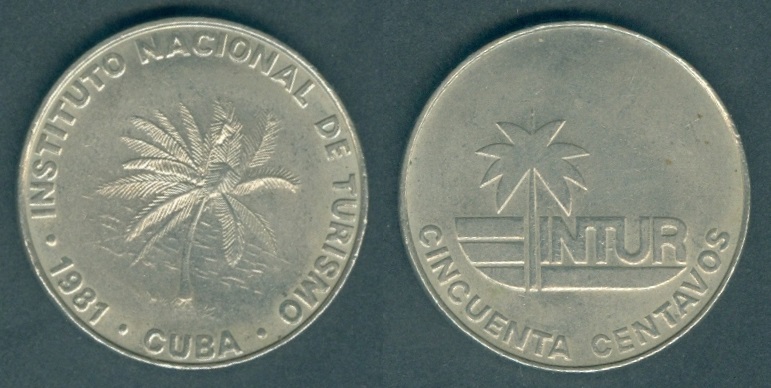 |
|
Cuba
KM#420 / Schön# 709.1
50
Centavos. Year:
1981. Weight:
11.60g [11.70 g]. Metal:
Copper-Nickel.
Diameter:
29.50 mm.
Edge:
Plain. Alignment:
Medal. Mint:
Empresa Cubana de Acuñaciones, Havana, Cuba.
Type: No
Numerals on the top center right side on Reverse side.
Obverse:
"INSTITUTO NACIONAL DE TURISMO"
(National Institute of Tourism) written in Spanish in the top
section. Real Palm tree in the center.
"• 1988 • CUBA •" written at the bottom left side.
Reverse:
Logo of the National
Institute of Tourism ("INTUR") featuring a Real Palm tree in the center. Value "CINCUENTA
CENTAVOS" (Fifty Centavos) written at
the bottom.
Mintage:
N/A.
Minted Years:
One year
type.
Sabal palmetto, also known as
cabbage-palm, palmetto, cabbage palmetto, blue palmetto, Carolina
palmetto, common palmetto, swamp cabbage and sabal palm, is one of
15 species of palmetto palm. It is native to the southern United
States, as well as Cuba, the Turks and Caicos Islands, and the
Bahamas.
In the United States, the native range of S. palmetto is the coastal
plain of the lower East Coast from southeast North Carolina
southward to Florida and west along the Gulf Coastal plain to Texas.
Real palm tree is the national tree of Cuba. It is in Cuba's Coat of
Arms, and in the INTUR (National Institute of Tourism) logo. This
tree is very common in Cuba. The tree reaching 25/30
meters high, and even 40 meters, with leaves about 6 meters long. It
is easily
identified by the shape of the trunk, bulged below top, and a long
vertical button on top.
The bristles on the sheaths of young leaves have been made into
scrubbing brushes. The trunks have been used as wharf piles. On 28
June 1776, Charleston patriots under William Moultrie (b. 23
November 1730 – d. 27 September 1805) made a fort of palmetto trunks
and from it defended successfully against the British in the
Revolutionary War. |
|
| |
|
1988 |
| |
|
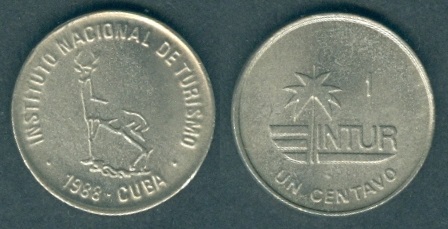 |
Cuba
KM#409 / Schön# 705
Centavo. Year:
1988. Weight:
2.92g [2.90 g]. Metal:
Copper-Nickel.
Diameter:
17.00 mm.
Edge:
Plain. Alignment:
Medal. Mint:
Empresa Cubana de Acuñaciones, Havana, Cuba. |
|
Obverse:
"INSTITUTO NACIONAL DE TURISMO"
(National Institute of Tourism) written in Spanish in the top
section. Stylized deer in the center.
"• 1988 • CUBA •" written at the bottom.
Reverse:
Logo of the National
Institute of Tourism ("INTUR") featuring a Real Palm tree in the center.
Numeral "1" written at the center right side. Value "UN CENTAVO"
(One Centavo) written at
the bottom.
Mintage:
N/A.
Minted Years:
One year
type. The white-tailed deer
(Odocoileus virginianus), also known as the whitetail or
Virginia deer, is a medium-sized deer native to North America,
Central America, Ecuador, and South America as far south as Peru and
Bolivia. It has also been introduced to New Zealand, Cuba, Jamaica,
Hispaniola, the Bahamas, the Lesser Antilles, and some countries in
Europe, such as the Czech Republic, Finland, Romania, Serbia,
Germany, and France. In the Americas, it is the most widely
distributed wild ungulate. |
|
| |
|
1989 |
| |
|
 |
Cuba
KM#415.2a / Schön# A707 10
Centavos. Year:
1989. Weight:
4.01g [4.00 g]. Metal:
Nickel plated Steel.
Diameter:
21.30 mm.
Edge:
Plain. Alignment:
Medal. Mint:
Empresa Cubana de Acuñaciones, Havana, Cuba.
Type: Dot between Date and
"CUBA" at the bottom on Obverse side. Small and close Numeral "10"
at the center right side on the Reverse
side. |
|
Obverse:
"INSTITUTO NACIONAL DE TURISMO"
(National Institute of Tourism) written in Spanish in the top
section. The bee hummingbird in the center.
"• 1989 • CUBA •" written at the bottom.
Reverse:
Logo of the National
Institute of Tourism ("INTUR") featuring a Real Palm tree in the center.
Numerals "10" written at the center right side. Value "DIEZ
CENTAVOS" (Ten Centavos) written at
the bottom.
Mintage:
N/A.
Minted Years:
One year
type (actually minted in 1993).
Note:
1989 is listed as KM#415.2 in
Copper-Nickel as well. |
|
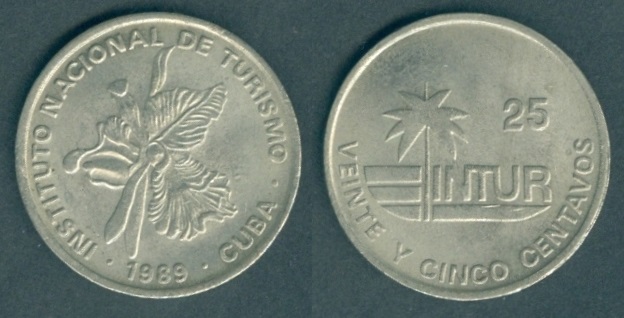 |
Cuba
KM#418.2 / Schön# 708.2
25
Centavos. Year:
1989. Weight:
6.41g [6.45 g]. Metal:
Copper-Nickel.
Diameter:
23.50 mm.
Edge:
Plain. Alignment:
Medal. Mint:
Empresa Cubana de Acuñaciones, Havana, Cuba. |
|
Obverse:
"INSTITUTO NACIONAL DE TURISMO"
(National Institute of Tourism) written in Spanish in the top
section. "Mariposa" (Spanish word for butterfly) flower in the center. "• 1989 • CUBA •" written at the bottom right side.
Reverse:
Logo of the National
Institute of Tourism ("INTUR") featuring a Real Palm tree in the center.
Numerals "25" written at the center right side. Value "VEINTE
Y CINCO CENTAVOS" (Twenty and Five Centavos) written at
the bottom section.
Mintage:
N/A.
Minted Years:
1981
(Large "25" = KM#418.1) and 1989 (Small "25"
= KM#418.2). Note:
1989 is listed as KM#415.2a in
Nickel plated Steel as well.
Schizanthus (also called butterfly flower, fringeflower,
poor-man's-orchid), is a genus of plants in the nightshade family,
Solanaceae. "Mariposa" (Spanish word for butterfly) flower is the
national flower of Cuba. It is very common in Cuba, with very nice
and sweet fragance. They are annual or biennial herbaceous plants,
with attractive flowers and they belong to the subfamily
Schizanthoideae of the Solanaceae. The genus includes species native
to Chile and Argentina, many species are adventitious in other parts
of the world such as New Zealand and the United States.
This flower was used by Celia Sánchez Manduley (b. 09 May 1920 – d.
11 January 1980) in the Cuban Revolution to hide telegrams. |
|
| |
| |
| Currency:
Cuba Convertible Peso = 100 centavos (visitor's
coinage, 1994-date). In
1994, coins were introduced in denominations of 5, 10, 25 and 50 centavos
and 1 peso. The 5 pesos (rarely seen) was introduced in 1999, followed by
the 1 centavo coins in 2000. 1994 issues are Medal alignment and produced by
Royal Canadian Mint at Ottawa, while from 1996 the remaining coins are Coin alignment
produced at Havana, Cuba. |
| |
|
1994 |
| |
|
 |
Cuba
KM#575.1 / Schön# 713
5
Centavos. Year:
1994. Weight:
2.64g [2.65 g]. Metal:
Nickel plated steel (magnetic).
Diameter:
17.50 mm.
Thickness: 1.50 mm.
Edge:
Reeded. Alignment:
Medal. Mint:
Ottawa,
Royal Canadian Mint. |
|
Obverse:
"REPUBLICA DE CUBA" (Republic
of Cuba) written in Spanish at the top. Cuba Coat of Arms in the
center. Date below Coat of Arms. "cinco centavos" (five
centavos) written in Spanish at the bottom. 8-sided shape on edge.
Reverse:
Colonial house in the center. Value "5¢" written at
the top right side. "CASA COLONIAL" (colonial house) written
in Spanish
above the building on the right side. 8-sided shape on edge.
Mintage:
N/A.
Minted Years:
One year
type. Engraver:
Charles Edward Barber (Obverse side).
Note:
The colonial house is a very common
construction in every town and city of Cuba, even at Havana. Many of
those were built in the 15th to 19th centuries, and are in good
conservation conditions. Some of them are museums, like the house of
Diego Velázquez, 1st governor of Cuba and founder of 7 towns. His
house was built about 1516/1530 and is a museum where are shown
articles, furniture and decorations of different ages, from 1500 to
1900. |
|
 |
Cuba
KM#576.1 / Schön# 714 10
Centavos. Year:
1994. Weight:
4.04g [4.00 g]. Metal:
Nickel plated steel (magnetic).
Diameter:
19.50 mm.
Thickness: 1.80 mm.
Edge:
Reeded. Alignment:
Medal. Mint:
Ottawa,
Royal Canadian Mint. |
|
Obverse:
"REPUBLICA DE CUBA" (Republic
of Cuba) written in Spanish at the top. Cuba Coat of Arms in the
center. Date below Coat of Arms. "diez centavos" (ten
centavos) written in Spanish at the bottom. 8-sided shape on edge.
Reverse:
Castillo de la Fuerza
(Castle of the Force) in the center. Value "10¢" written at the
top left side. "CASTILLO DE LA FUERZA" (Castle of the
Force) written
in Spanish
above the building. 8-sided shape on edge.
Mintage:
N/A.
Minted Years:
One year
type. Engraver:
Charles Edward Barber (Obverse side).
Note:
The Castillo de la Real Fuerza (English
Castle of the Royal Force) is a bastion fort on the western side of
the harbour in Havana, Cuba, set back from the entrance, and
bordering the Plaza de Armas. Originally built to defend against
attack by pirates, it suffered from a poor location; it is too far
inside the bay. The fort is considered to be the oldest stone fort
in the Americas, and was listed in 1982 as part of the UNESCO World
Heritage site of "Old Havana and its Fortifications".
A previous fort, the Fuerza Vieja (Old Fort), was badly damaged in
1555 during an attack on Havana by the French privateer Jacques de
Sores and eventually was demolished in 1582. In 1558 Bartolomé
Sánchez, an engineer appointed by King Philip II of Spain, began
work on the new fort, initially known as the Fuerza Nueva (New
Fort). The Fuerza Vieja was set back from the harbour, but the new
fort was planned to be closer to the harbour to give it a better
location. The ironworks were established in 1558, but the first
stones were not laid until 1562. Construction was delayed due to
complaints from local residents forced to relocate to make way for
the building and from disagreements between Sánchez and the Governor
of Havana. The fort was not completed until 1577, with slaves and
French prisoners providing most of the labour. The fort was built of
limestone quarried from the Havana shoreline and the fortification
incorporated thick sloping walls, a moat, and a drawbridge. The
governor, Francisco Carreño, ordered the addition an upper storey as
barracks and a munitions store, but on completion, the fort proved
to be too small for practical use.
In 1634, Juan Vitrián de Viamonte added a watchtower with a
weathervane sculpted in the form of a woman, by Gerónimo Martín
Pinzón, an artist from Havana, and based on the figure crowning La
Giralda in Seville. The façade of the fortress was demolished in
1851 to allow O’Reilly Street to go all the way to the docks, and
prevent the fort from overshadowing El Templete, which was completed
in 1828.
The fort was home to the National Archive from 1899 and the National
Library from 1938 up until 1957, when both were relocated to a
purpose-built library in Plaza de la Revolución. After the Cuban
Revolution in 1959, the fort housed the offices of the National
Commission of Monuments and the Centre of Preservation, Restoration
and Museology. The fort served briefly as the Museum of Arms, but
the conditions within the fortress were not conducive to the
preservation of the displays.
In 1977, on the 400th anniversary of completion, the building was
inaugurated as a museum and used to display exhibitions of Cuban
contemporary and international art. In 1990, it became the National
Museum of Cuban Ceramics.
In 2010, Castillo de la Real Fuerza reopened as Cuba’s premier
maritime museum. (There is also a small naval museum in Cienfuegos.)
The museum contains excellent exhibits of Cuba’s maritime past from
pre-Columbian days through to the 18th century with the Royal
Shipyard of Havana, one of the largest in the world, which built
nearly 200 ships for the Spanish Crown. The museum features a huge
four-metre model of the Santisima Trinidad located on the main floor
with a large interactive touch screen in Spanish, French, and
English. The exhibit describes life aboard an 18th-century
ship-of-the-line. The original ship was launched into Havana Bay on
2 March 1769 and was the largest ship in the world in the 18th
century, with 140 cannons on four gun decks. She was one of four
Cuban-built ships at the Battle of Trafalgar in 1805. Downstairs you
will find ancient navigational instruments, underwater
archaeological artifacts, and gold and silver from the colonial era.
Also note the original weathervane, La Giraldilla, while her replica
moves in the breeze on the top of the fortress tower, which also
commands a fantastic view of the city. The second level of the
museum hosts many other historic and contemporary models of ships
with links to Cuba and is also a good location for viewing the
harbour and city skyline. |
|
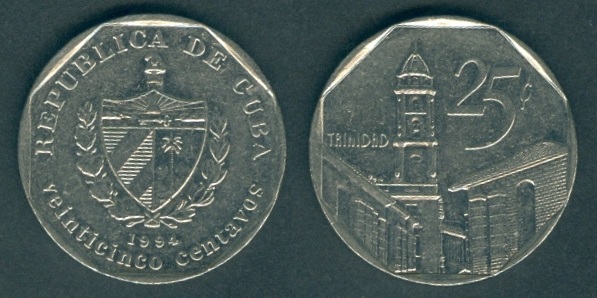 |
Cuba
KM#577.1 / Schön# 715 25
Centavos. Year:
1994. Weight:
5.64g [5.65 g]. Metal:
Nickel plated steel (magnetic).
Diameter:
19.50 mm.
Thickness:
1.80 mm. Edge:
Reeded. Alignment:
Medal. Mint:
Ottawa,
Royal Canadian Mint. |
|
Obverse:
"REPUBLICA DE CUBA" (Republic
of Cuba) written in Spanish at the top. Cuba Coat of Arms in the
center. Date below Coat of Arms. "veinticinco centavos"
(twenty-five
centavos) written in Spanish at the bottom. 8-sided shape on edge.
Reverse:
A street in Trinidad,
traditional houses and the Church of San Francisco de Asis in the center. Value "25¢"
written at the top left side. "TRINIDAD" (Trinity) written
in Spanish
above the building at center left side. 8-sided shape on edge.
Mintage:
N/A.
Minted Years:
One year
type. Engraver:
Charles Edward Barber (Obverse side).
Note:
Trinidad is a town in the
province of Sancti Spíritus, central Cuba. Together with the nearby
Valle de los Ingenios, it has been a UNESCO World Heritage site
since 1988.
Trinidad was founded on 23 December 1514 by Diego Velázquez de
Cuéllar under the name Villa de la Santísima Trinidad. Hernán Cortés
recruited men for his expedition from Juan de Grijalva's home in
Trinidads, and Sancti Spíritus, at the start of his 1518 expedition.
This included Pedro de Alvarado and his five brothers. After ten
days, Cortes sailed, the alcayde Francisco Verdugo failing to
prevent Cortes from leaving, despite orders from Diego Velázquez.
The Narvaez Expedition landed at Trinidad in 1527 en route to
Florida. Caught in a hurricane, the expedition lost two ships,
twenty horses and sixty men to the violent storm.
Francisco Iznaga, a Basque landowner in the southern portion of Cuba
during the first 30 years of the colonization of Cuba, was elected
Mayor of Bayamo in 1540. Iznaga was the originator of a powerful
lineage which finally settled in Trinidad where the Torre Iznaga (Iznaga
Tower) is. His descendants fought for the independence of Cuba and
for annexation to the U.S., from 1820 to 1900. Trinidad is one of
the best-preserved cities in the Caribbean from the time when the
sugar trade was the main industry in the region. |
|
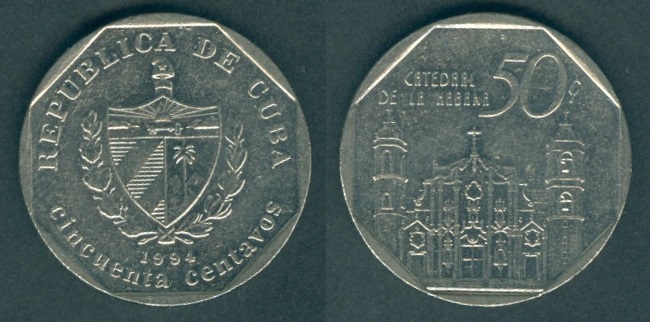 |
Cuba
KM#578.1 / Schön# 716 50
Centavos. Year:
1994. Weight:
7.49g [7.50 g]. Metal:
Nickel plated steel (magnetic).
Diameter:
24.50 mm.
Thickness:
2.00 mm. Edge:
Reeded. Alignment:
Medal. Mint:
Ottawa,
Royal Canadian Mint. |
|
Obverse:
"REPUBLICA DE CUBA" (Republic
of Cuba) written in Spanish at the top. Cuba Coat of Arms in the
center. Date below Coat of Arms. "cincuenta centavos"
(fifty
centavos) written in Spanish at the bottom. 8-sided shape on edge.
Reverse:
The Havana Cathedral in the center. Value "50¢"
written at the top right side. "CATEDRAL DE LA HABANA" (The
Havana Cathedral) written
in Spanish
at the top left side in two line. 8-sided shape on edge.
Mintage:
N/A.
Minted Years:
One year
type. Engraver:
Charles Edward Barber (Obverse side).
Note:
Havana Cathedral (Catedral de
San Cristobal) is one of eleven Catholic cathedrals on the island.
It is located in the Plaza de la Catedral on Calle Empedrado,
between San Ignacio y Mercaderes, Old Havana. The thirty by
forty-nine meters rectangular church serves as the seat of the Roman
Catholic Archdiocese of San Cristobal de la Habana.[1] Christopher
Columbus’ remains were kept in the cathedral between 1796 and 1898
before they were taken to Seville Cathedral. It was built between
1748-1777 and was consecrated in 1782.
The Roman Catholic Metropolitan Archdiocese of San Cristobal de la
Habana (Latin: Archidioecesis Avanensis) is one of three Catholic
archdioceses in Cuba. This Latin Rite or Roman Rite diocese was
erected on 10 September 1787 by Pope Pius VI, from the territory of
the then–Diocese of Santiago de Cuba. When it was erected, the new
diocese encompassed the secular provinces of Santa Clara, Matanzas,
Havana, and Pinar del Río in Cuba and Florida and Louisiana in what
is now the United States of America. On 25 April 1793 the diocese
lost territory for what would be the first of four territorial
losses when the Diocese of Louisiana and the Two Floridas (Saint
Louis of New Orleans) was erected. The diocese again lost territory
on 20 February 1903 when the dioceses of Pinar del Río and
Cienfuegos were erected, and then again on 10 December 1912 upon the
erection of the diocese of Matanzas. Eventually the diocese was
elevated to the Metropolitan See of Sancti Christophori de Habana,
San Cristobal de la Habana on 06 January 1925.
The cathedral contains a number of sculptures, paintings and
frescoes. There is a statute of Apolinar Serrano (23 July 1833 - 15
June 15 1876) who was a Spanish bishop of Havana and was buried in
the Cathedral. Copies of paintings in the side chapels by Rubens and
Murillo on the altars. There is a sculpture of Saint Christopher,
Patron Saint of Havana, which dates from 1632 and was made by Martín
de Andújar Cantos in Seville, Spain. Above the altar are three
fading frescoes by Italian artist Giuseppe Perovani, a neoclassical
artist who was commissioned by Bishop Juan José Díaz de Espada y
Fernánez de Landa of the Roman Catholic Archdiocese of San Cristóbal
de la Habana to paint three scenes: The Delivery of the Keys, The
Last Supper and The Ascension. There is also the canvas of the
Virgin of the Immaculate Conception, Patroness of the Cathedral.
Perovani was also the author of the canvas of the orange chapel
(color of the ceiling) of the Virgin of Loreto, blessed by Bishop
Morell de Santa Cruz in 1755. On the altar are sculptures and
goldsmith works made in Rome during the first half of the XIX
century. On the walls the oil paintings painted by the Frenchman
Jean-Baptiste Vermay, founder and first director of the Academy of
Painting and Drawing of San Alejandro, the same creator of the
interior works of the El Templete, in the original enclave of the
city.
The cathedral stands within the area of Old Havana that UNESCO
designated a World Heritage Site in 1982. |
|
| |
| 1996 |
| |
|
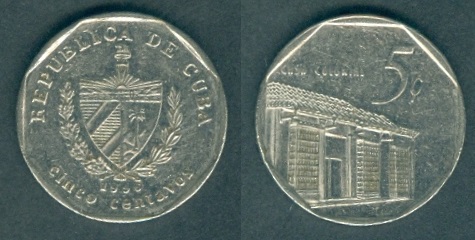 |
Cuba
KM#575.2 / Schön# 713
5
Centavos. Year:
1996. Weight:
2.62g [2.65 g]. Metal:
Nickel plated steel (magnetic).
Diameter:
17.50 mm.
Thickness: 1.50 mm.
Edge:
Reeded. Alignment:
Coin. Mint:
Empresa Cubana de Acuñaciones, Havana, Cuba. |
|
Obverse:
"REPUBLICA DE CUBA" (Republic
of Cuba) written in Spanish at the top. Cuba Coat of Arms in the
center. Date below Coat of Arms. "cinco centavos" (five
centavos) written in Spanish at the bottom. 8-sided shape on edge.
Reverse:
Colonial house in the center. Value "5¢" written at
the top right side. "CASA COLONIAL" (colonial house) written
in Spanish
above the building on the right side. 8-sided shape on edge.
Mintage:
N/A.
Minted Years:
1996,
1998, 1999, 2000, 2000 Small Date, 2001, 2002, 2003, 2004, 2006,
2007, 2008, 2009, 2013, 2016, 2017 and 2018. Engraver:
Charles Edward Barber (Obverse side). |
|
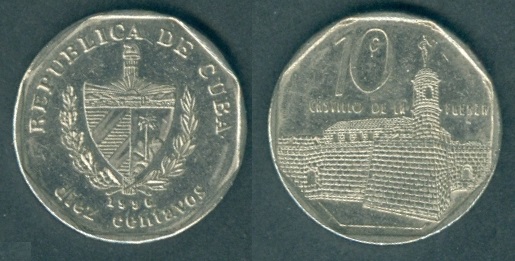 |
Cuba
KM#576.2 / Schön# 714 10
Centavos. Year:
1996. Weight:
4.01g [4.00 g]. Metal:
Nickel plated steel (magnetic).
Diameter:
19.50 mm.
Thickness: 1.80 mm.
Edge:
Reeded. Alignment:
Coin. Mint:
Empresa Cubana de Acuñaciones, Havana, Cuba. |
|
Obverse:
"REPUBLICA DE CUBA" (Republic
of Cuba) written in Spanish at the top. Cuba Coat of Arms in the
center. Date below Coat of Arms. "diez centavos" (ten
centavos) written in Spanish at the bottom. 8-sided shape on edge.
Reverse:
Castillo de la Fuerza
(Castle of the Force) in the center. Value "10¢" written at the
top left side. "CASTILLO DE LA FUERZA" (Castle of the
Force) written
in Spanish
above the building. 8-sided shape on edge.
Mintage:
N/A.
Minted Years:
1996,
1999,
2000, 2002, 2003, 2008, 2009, 2013, 2016, 2017 and 2018. Engraver:
Charles Edward Barber (Obverse side). |
|
| |
| 1998 |
| |
|
 |
Cuba
KM#577.2 / Schön# 715 25
Centavos. Year:
1998. Weight:
5.66g [5.65 g]. Metal:
Nickel plated steel (magnetic).
Diameter:
19.50 mm.
Thickness:
1.80 mm. Edge:
Reeded. Alignment:
Coin. Mint:
Empresa Cubana de Acuñaciones, Havana, Cuba. |
|
Obverse:
"REPUBLICA DE CUBA" (Republic
of Cuba) written in Spanish at the top. Cuba Coat of Arms in the
center. Date below Coat of Arms. "veinticinco centavos"
(twenty-five
centavos) written in Spanish at the bottom. 8-sided shape on edge.
Reverse:
A street in Trinidad,
traditional houses and the Church of San Francisco de Asis in the center. Value "25¢"
written at the top left side. "TRINIDAD" (Trinity) written
in Spanish
above the building at center left side. 8-sided shape on edge.
Mintage:
N/A.
Minted Years:
1998,
2000, 2001, 2002, 2003, 2003 Narrow Date, 2004, 2006, 2006 Thick
date, 2007, 2008 Curved Date, 2009, 2016, 2017 and 2018. Engraver:
Charles Edward Barber (Obverse side). |
|
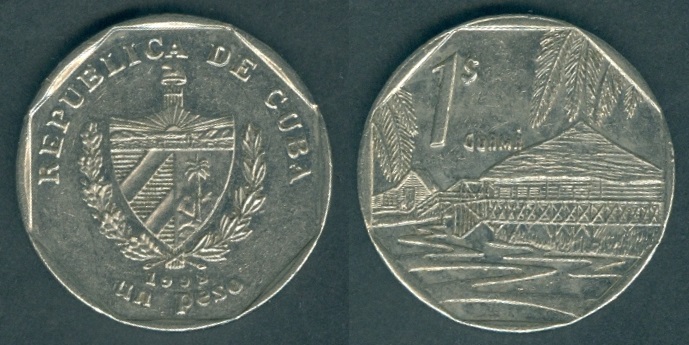 |
|
Cuba
KM#579.2 / Schön# 717
Peso. Year:
1998. Weight:
8.49g [8.50 g]. Metal:
Nickel plated steel (magnetic).
Diameter:
26.50 mm.
Thickness:
2.00 mm. Edge:
Reeded. Alignment:
Coin. Mint:
Empresa Cubana de Acuñaciones, Havana, Cuba.
Type1: Date
Far from the Wreath.
Obverse:
"REPUBLICA DE CUBA" (Republic
of Cuba) written in Spanish at the top. Cuba Coat of Arms in the
center. Date below Coat of Arms. "un peso"
(one peso) written in Spanish at the bottom. 8-sided shape on edge.
Reverse:
View of Guamá ville in the center. Value "1$"
(One Peso) written at the top left side. "GUAMÁ" is written
left side of the roof of the hut. 8-sided shape on edge.
Mintage:
N/A.
Minted Years:
1998,
2000 Wide Curved Date, 2001, 2007 Thin small narrow Date, 2012, 2016
Wide straight Date, 2017 Wide straight Date and 2018. Engraver:
Charles Edward Barber (Obverse side).
KM#579.1 is produced in 1994 as Medal alignment.
Guamá (died c. 1532) was a Taíno rebel chief who led a
rebellion against Spanish rule in Cuba in the 1530s. Taínos (name of
the tribe) were slaved to work in the gold mines. Legend states that
Guamá was first warned about the Spanish conquistador by Hatuey, a
Taíno cacique from the island of Hispaniola.
After the death of Spanish governor Diego de Velázquez (circa
1460-1524), Guamá led a series of bloody indigenous uprisings
against the Spanish that lasted for roughly 10 years. By 1530 Guamá
had about fifty warriors and continued to recruit more pacified
yndios. The rebellion mainly occurred in the extensive forests of
the area of Çagua, near Baracoa in the easternmost area of Cuba, but
also farther south and west in the Sierra Maestra.
Archaeologists and forensic pathologists believe that a body found
in the Cuban mountains in February 2003 is indeed that of the
legendary rebel chief Guamá. According to the testimony of a captive
Indian taken by the Spanish during the rebellion, Guamá was murdered
by his brother Oliguama, who buried an axe in his forehead while he
slept, in 1532. According to oral tradition Oliguama, also spelled
Holguoma, killed Guamá because of a sexual relationship between
Guamá and Oliguama's wife.
The death of Guamá and the capture and execution of his warrior wife
Casiguaya, plus the killing or dispersal of most of the group by a
cuadrilla, a war party of Spanish, Indians and Blacks under the
orders of Spanish governor Manuel de Rojas, ended major resistance
to the Spanish by 1533. Brizuela of Baitiquirí (Zayas, 1914) fought
on until about 1540, when he was captured and imprisoned.
Guamá Ville is a touristic complex, placed in the Ciénaga de
Zapata, situated about 150 km to southeast of Havana. Has several
huts, built using the traditional materials and techniques, a great
diversity of fauna and flora, declared as Biosphere Reserve on 2000,
also has a Cuban crocodile breeding farm.
Guamá Ville is a touristic complex, placed in the Ciénaga de Zapata,
situated about 150 km to southeast of Havana. Has several huts,
built using the traditional materials and techniques, a great
diversity of fauna and flora, declared as Biosphere Reserve on 2000,
also has a Cuban crocodile breeding farm. |
|
|
 |
 |
|
Type2: Date
Close to the Wreath.
Weight:
8.51g [8.50 g]. |
|
| |
| 1999 |
| |
|
 |
Same as above KM#575.2 five
centavos,
but...
Year: 1999.
Weight: 2.66 g
[2.65g]. Mint:
Empresa Cubana de Acuñaciones, Havana, Cuba.
Mintage:
N/A. |
|
 |
Same as above KM#576.2 ten
centavos,
but...
Year: 1999.
Weight: 4.02 g
[4.00g]. Mint:
Empresa Cubana de Acuñaciones, Havana, Cuba.
Mintage:
N/A.
Type1: Date
Far from the Wreath. |
|
 |
Same as above coin but...
Type2: Date
Close to the Wreath.
Weight:
3.99g [4.00 g]
|
|
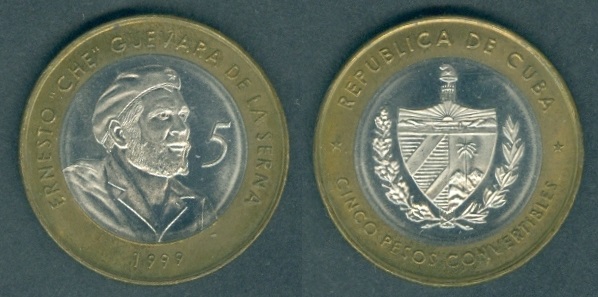 |
Cuba
KM#730 / Schön# 718
5 Pesos. Year:
1999. Weight:
4.45g [4.50 g]. Metal:
Bimetallic; Nickel plated steel (center) and
Brass plated steel (ring).
Diameter:
23.00 mm.
Thickness: 1.64 mm.
Edge:
Reeded. Alignment:
Coin. Mint:
Empresa Cubana de Acuñaciones, Havana, Cuba. |
|
Obverse:
"ERNESTO "CHE" GUEVARA DE LA SERNA" (Guevara´s
full name) written in the top section. Guevara facing right in the
center with Numeral "5" in front of his mouth. Date "1999" written
at the bottom.
Reverse:
"REPUBLICA DE CUBA" (Republic of Cuba)
written in Spanish at the top. Cuba Coat of Arms in the center. One
star on the left side and one star of the right side. "CINCO PESOS
CONVERTIBLES" (Five Convertible Pesos) written in Spanish at the
bottom.
Mintage:
N/A.
Minted Years:
One year type. Engraver:
Charles Edward Barber (Obverse side).
Subject: 40th
anniversary of Ernesto "Che" Guevara as President of Banco Nacional
de Cuba (BNC). Coin was minted in 1999, but issued in 2004
(45th anniversary of the event). Ernesto
"Che" Guevara headed the National Bank of Cuba (BNC) for 456
days (26 November 1959 - 1961). This
was possibly the shortest period of time that Che dedicated to a
task of such significance and, according to many historians, it is
the period least known about his life.
By 26 November 1959, the date on which he assumed the presidency of
the BNC, the Cuban bank was in a critical situation. As yet not
nationalized and with scant reserves, given that the majority of its
assets had been stolen and taken to the United States, the inherited
banking system lacked the conditions to promote the newly
independent country’s economic and social development.
In this context, the revolutionary government’ principal intention
was to recover financial control of the banking system and place it
in the hands of the state, including the functions of conserving and
guarding the monetary funds owned by the National Bank. Naturally,
all of this militated against U.S. plans to destabilize the national
economy.
The Cuban government’s response to this U.S. proposition was swift.
Under Che’s presidency, the flight of hard currency from the country
was controlled, the BNC was nationalized, the Organic Bank Law was
drafted and the return for counterrevolutionary purposes of capital
taken out of the country was avoided.
The Central Bank of Cuba (Spanish:
Banco Central de Cuba, BCC) is now the central bank of Cuba. It was
created in 1997 to take over many of the functions of the National
Bank of Cuba (Spanish: Banco Nacional de Cuba) which was established
in 1950.
Ernesto "Che" Guevara (14 June 1928 – 09 October 1967) was
an Argentine Marxist revolutionary, physician, author, guerrilla
leader, diplomat, and military theorist. A major figure of the Cuban
Revolution, his stylized visage has become a ubiquitous
countercultural symbol of rebellion and global insignia in popular
culture.
As a young medical student, Guevara traveled throughout South
America and was radicalized by the poverty, hunger, and disease he
witnessed. His burgeoning desire to help overturn what he saw as the
capitalist exploitation of Latin America by the United States
prompted his involvement in Guatemala's social reforms under
President Jacobo Árbenz, whose eventual CIA-assisted overthrow at
the behest of the United Fruit Company solidified Guevara's
political ideology. Later in Mexico City, Guevara met Raúl and Fidel
Castro, joined their 26th of July Movement, and sailed to Cuba
aboard the yacht Granma with the intention of overthrowing
U.S.-backed Cuban dictator Fulgencio Batista. Guevara soon rose to
prominence among the insurgents, was promoted to second in command
and played a pivotal role in the victorious two-year guerrilla
campaign that deposed the Batista regime.
Following the Cuban Revolution, Guevara performed a number of key
roles in the new government. These included reviewing the appeals
and firing squads for those convicted as war criminals during the
revolutionary tribunals, instituting agrarian land reform as
minister of industries, helping spearhead a successful nationwide
literacy campaign, serving as both national bank president and
instructional director for Cuba's armed forces, and traversing the
globe as a diplomat on behalf of Cuban socialism. Such positions
also allowed him to play a central role in training the militia
forces who repelled the Bay of Pigs Invasion, and bringing Soviet
nuclear-armed ballistic missiles to Cuba, which preceded the 1962
Cuban Missile Crisis. Additionally, Guevara was a prolific writer
and diarist, composing a seminal manual on guerrilla warfare, along
with a best-selling memoir about his youthful continental motorcycle
journey. His experiences and studying of Marxism–Leninism led him to
posit that the Third World's underdevelopment and dependence was an
intrinsic result of imperialism, neocolonialism and monopoly
capitalism, with the only remedy being proletarian internationalism
and world revolution. Guevara left Cuba in 1965 to foment revolution
abroad, first unsuccessfully in Congo-Kinshasa and later in Bolivia,
where he was captured by CIA-assisted Bolivian forces and summarily
executed by shooting. He died on 09 October 1967 (aged 39) at La
Higuera, Vallegrande, Bolivia. |
|
| |
|
2000 |
| |
|
 |
Cuba
KM#729 / Schön# 712
Centavo. Year:
2000. Weight:
1.72g [1.70 g]. Metal:
Copper plated steel (magnetic).
Diameter:
14.50 mm.
Thickness: 1.43 mm.
Edge:
Reeded. Alignment:
Coin. Mint:
Empresa Cubana de Acuñaciones, Havana, Cuba. |
|
Obverse:
"REPUBLICA DE CUBA" (Republic
of Cuba) written in Spanish at the top. Cuba Coat of Arms in the
center. Date below Coat of Arms. "un centavo" (one
centavo) written in Spanish at the bottom. 8-sided shape on edge.
Reverse:
"Plaza de la Revolución"
(Revolution Square) at Havana in the center. Value "1¢" written at
the top right side with "PLAZA DE LA REVOLUCIÓN" written in two
lines below it. 8-sided shape on edge.
Mintage:
N/A.
Minted Years:
2000,
2002, 2002 Thick Date, 2006, 2007, 2013, 2016 and 2017.
Engraver:
Charles Edward Barber (Obverse side).
Note:
The Revolution Square Plaza is
31st largest city square in the world, measuring 72,000 square
meters. The square is notable as being where many political rallies
take place and Fidel Castro and other political figures address
Cubans. Fidel Castro addressed more than a million Cubans on many
important occasions, such as 1 May and 26 July each year. Pope John
Paul II, during his 1998 first visit by a Pope, and Pope Francis in
2015, held large Masses there during papal visits to Cuba.
The square is dominated by the José Martí Memorial, which features a
109 m (358 ft) tall tower and an 18 m (59 ft) statue. The National
Library, many government ministries, and other buildings are located
in and around the Plaza. Located behind the memorial is the Palace
of the Revolution, the seat of the Cuban government and Communist
Party. Opposite the memorial are the offices of the Ministries of
the Interior and Communications, whose facades feature matching
steel memorials of the two most important deceased heroes of the
Cuban Revolution: Che Guevara, with the quotation "Hasta la Victoria
Siempre" (Until the Everlasting Victory, Always) and Camilo
Cienfuegos (sometimes mistaken for Fidel Castro), with the quotation
"Vas bien, Fidel" (You're doing fine, Fidel). It is also the site of
several cultural institutions.
Charles Edward Barber (16
November 1840 – 18 February 1917) was the sixth chief engraver of
the United States Mint from 1879 until his death in 1917. Besides
designing US coins of Barber half dollar, Barber quarter, Barber
dime and Liberty Head nickel, he also designed Cuba coins during
1915-1961: 1, 2, 5, 10, 20 & 40 Centavos. |
|
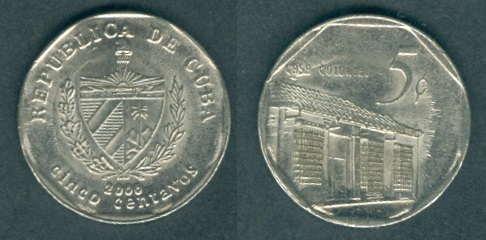 |
Same as above KM#575.2 five
centavos,
but...
Year: 2000.
Weight: 2.69 g
[2.65g]. Mint:
Empresa Cubana de Acuñaciones, Havana, Cuba.
Mintage:
N/A. |
|
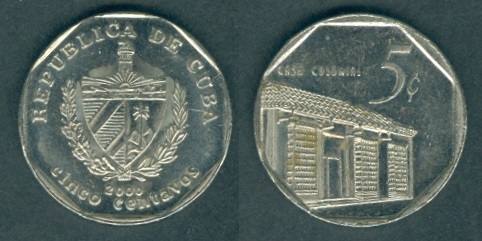 |
 |
|
Same as above coin but having Double Strike Date as shown.
Weight: 2.67 g
[2.65g]. |
|
 |
Same as above coin but having "Small
Date" variety.
Weight: 2.67 g
[2.65g]. |
|
 |
Same as above KM#576.2 ten
centavos,
but...
Year: 2000.
Weight: 3.95 g
[4.00g]. Mint:
Empresa Cubana de Acuñaciones, Havana, Cuba.
Mintage:
N/A. |
|
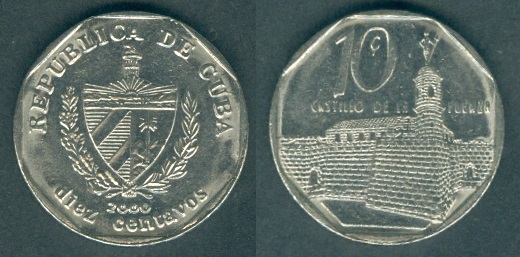 |
Same as above coin but having slightly Thick Date.
Weight: 3.96 g
[4.00g]. |
|
 |
Same as above KM#577.2
twenty-five
centavos,
but...
Year: 2000.
Weight: 5.69 g
[5.65g]. Mint:
Empresa Cubana de Acuñaciones, Havana, Cuba.
Mintage:
N/A. |
|
| |
|
2001 |
| |
|
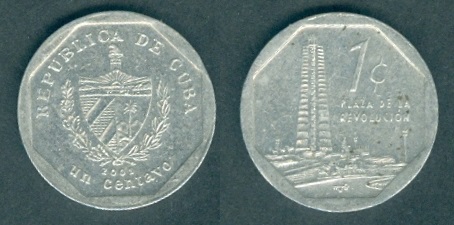 |
Cuba
KM#733 / Schön# 712a
Centavo.
Year:
2001. Weight:
0.74g [0.75 g].
Metal:
Aluminium.
Diameter:
16.50 mm.
Thickness: 1.50 mm.
Edge:
Plain. Alignment:
Coin. Mint:
Empresa Cubana de Acuñaciones, Havana,
Cuba. |
|
Obverse:
"REPUBLICA DE CUBA" (Republic
of Cuba) written in Spanish at the top. Cuba Coat of Arms in the
center. Date below Coat of Arms. "un centavo" (one
centavo) written in Spanish at the bottom. 8-sided shape on edge.
Reverse:
"Plaza de la Revolución"
(Revolution Square) at Havana in the center. Value "1¢" written at
the top right side with "PLAZA DE LA REVOLUCIÓN" written in two
lines below it. 8-sided shape on edge.
Mintage:
N/A.
Minted Years:
2000,
2001, 2002, 2003, 2005, 2007, 2015 and 2019.
Engraver: Charles
Edward Barber (Obverse side). |
|
| |
|
2002 |
| |
|
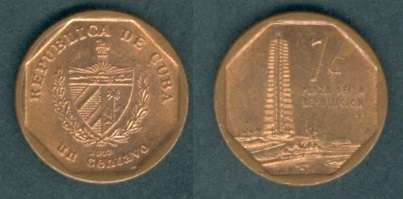 |
Same as above KM#729
centavo,
but...
Year: 2002.
Weight: 1.69 g
[1.70g]. Mint:
Empresa Cubana de Acuñaciones, Havana, Cuba.
Mintage:
N/A. |
|
 |
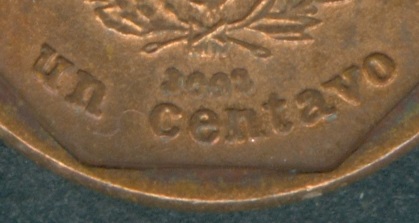 |
|
Same as above coin, but having Thick date as shown.
Weight: 1.71 g
[1.70g]. |
|
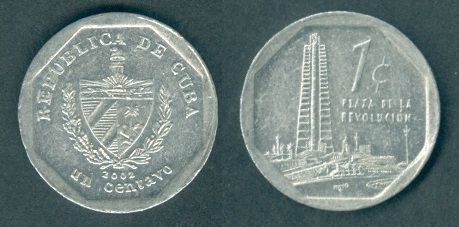 |
Same as above KM#733
centavo,
but...
Year: 2002.
Weight: 0.74 g
[0.75g]. Mint:
Empresa Cubana de Acuñaciones, Havana, Cuba.
Mintage:
N/A. |
|
 |
Same as above KM#575.2 five
centavos,
but...
Year: 2002.
Weight: 2.66 g
[2.65g]. Mint:
Empresa Cubana de Acuñaciones, Havana, Cuba.
Mintage:
N/A. |
|
 |
Same as above KM#576.2 ten
centavos,
but...
Year: 2002.
Weight: 4.01 g
[4.00g]. Mint:
Empresa Cubana de Acuñaciones, Havana, Cuba.
Mintage:
N/A. |
|
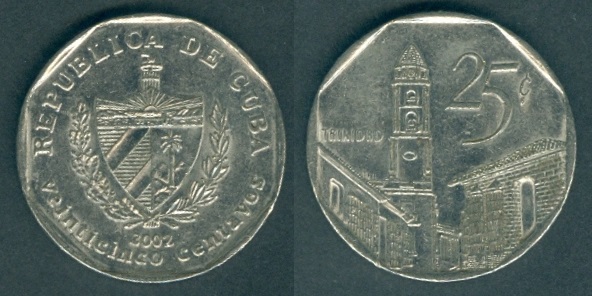 |
Same as above KM#577.2
twenty-five
centavos,
but...
Year: 2002.
Weight: 5.65 g
[5.65g]. Mint:
Empresa Cubana de Acuñaciones, Havana, Cuba.
Mintage:
N/A. |
|
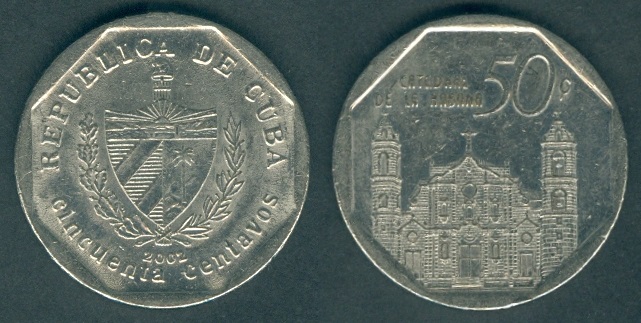 |
Cuba
KM#578.2 / Schön# 716 50
Centavos. Year:
2002. Weight:
7.53g [7.50 g]. Metal:
Nickel plated steel (magnetic).
Diameter:
24.50 mm.
Thickness:
2.00 mm. Edge:
Reeded. Alignment:
Medal. Mint:
Empresa Cubana de Acuñaciones, Havana, Cuba.
Type:
Thin Legends on Obverse side. |
|
Obverse:
"REPUBLICA DE CUBA" (Republic
of Cuba) written in Spanish at the top. Cuba Coat of Arms in the
center. Date below Coat of Arms. "cincuenta centavos"
(fifty
centavos) written in Spanish at the bottom. 8-sided shape on edge.
Reverse:
The Havana Cathedral in the center. Value "50¢"
written at the top right side. "CATEDRAL DE LA HABANA" (The
Havana Cathedral) written
in Spanish
at the top left side in two line. 8-sided shape on edge.
Mintage:
N/A.
Minted Years:
2002
Obverse Thin Legends, 2002 Obverse Thick legends, 2007, 2016, 2017
and 2018. Engraver:
Charles Edward Barber (Obverse side). |
|
| |
|
2003 |
| |
|
 |
Same as above KM#577.2
twenty-five
centavos,
but...
Year: 2003.
Weight: 5.68 g
[5.65g]. Mint:
Empresa Cubana de Acuñaciones, Havana, Cuba.
Mintage:
N/A.
Normal "Wide Date" variety. |
|
 |
Same as above coin but having "Narrow
Date" variety. 5.68 g
[5.65g]. |
|
| |
| |
|
2005 |
| |
|
 |
Same as above KM#733
centavo,
but...
Year: 2005.
Weight: 0.78 g
[0.75g]. Mint:
Empresa Cubana de Acuñaciones, Havana, Cuba.
Mintage:
N/A. |
|
| |
|
2006 |
| |
|
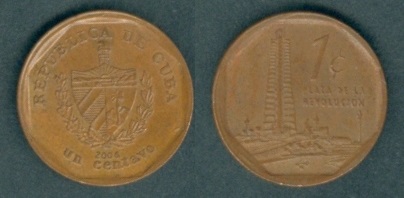 |
Same as above KM#729
centavo,
but...
Year: 2006.
Weight: 1.71 g
[1.70g]. Mint:
Empresa Cubana de Acuñaciones, Havana, Cuba.
Mintage:
N/A. |
|
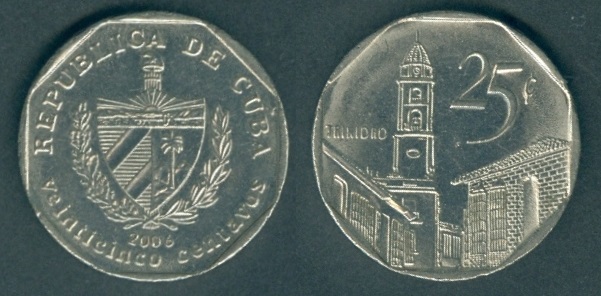 |
Same as above KM#577.2
twenty-five
centavos,
but...
Year: 2006.
Weight: 5.78 g
[5.65g]. Mint:
Empresa Cubana de Acuñaciones, Havana, Cuba.
Mintage:
N/A. |
|
| |
|
2007 |
| |
|
 |
Same as above KM#729
centavo,
but...
Year: 2007.
Weight: 1.71 g
[1.70g]. Mint:
Empresa Cubana de Acuñaciones, Havana, Cuba.
Mintage:
N/A. |
|
|
 |
Same as above KM#579.2
One Peso,
but...
Year: 2007.
Weight: 8.53 g
[8.50g]. Mint:
Empresa Cubana de Acuñaciones, Havana, Cuba.
Mintage:
N/A.
Instead of having rotation at 6 o'clock this coin
has rotation at 11 o'clock. |
|
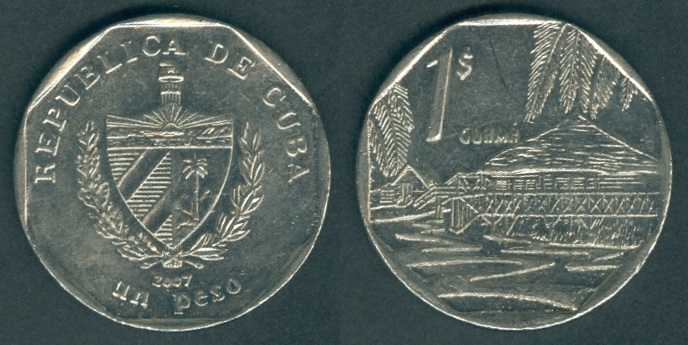 |
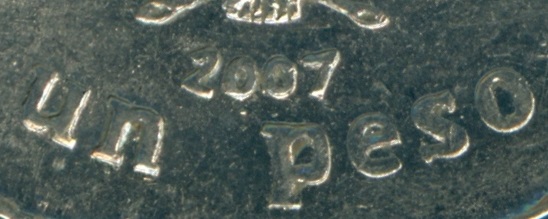 |
| Same as above coin but having proper Coin alignment.
Just a small dot below the first Zero in Date. The weight is
surprising also somehow less.
Weight: 8.33 g
[8.50g]. |
|
| |
|
2008 |
| |
|
 |
Same as above KM#576.2
ten
centavos,
but...
Year: 2008.
Weight: 3.91 g
[4.00g]. Mint:
Empresa Cubana de Acuñaciones, Havana, Cuba.
Mintage:
N/A. |
|
 |
Same as above KM#577.2
twenty-five
centavos,
but...
Year: 2008.
Weight: 5.59 g
[5.65g]. Mint:
Empresa Cubana de Acuñaciones, Havana, Cuba.
Mintage:
N/A.
This Date is known to have "Curved Date". |
|
| |
|
2013 |
| |
|
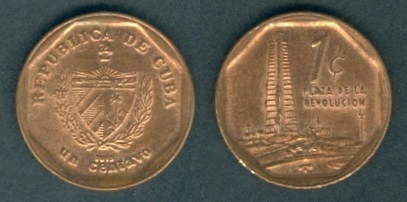 |
Same as above KM#729
centavo,
but...
Year: 2013.
Weight: 1.71 g
[1.70g]. Mint:
Empresa Cubana de Acuñaciones, Havana, Cuba.
Mintage:
N/A. |
|
| |
|
2016 |
| |
|
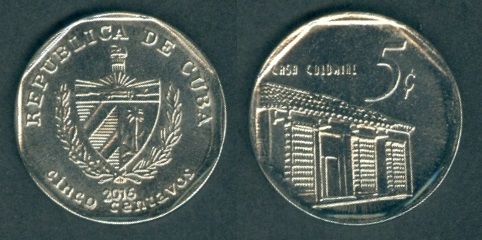 |
Same as above KM#575.2
five
centavos,
but...
Year: 2016.
Weight: 2.64 g
[2.65g]. Mint:
Empresa Cubana de Acuñaciones, Havana, Cuba.
Mintage:
N/A. |
|
 |
Same as above KM#576.2
ten
centavos,
but...
Year: 2016.
Weight: 3.91 g
[4.00g]. Mint:
Empresa Cubana de Acuñaciones, Havana, Cuba.
Mintage:
N/A. |
|
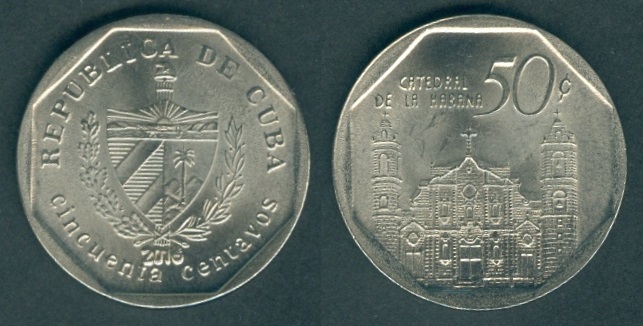 |
Same as above KM#578.2
fifty
centavos,
but...
Year: 2016.
Weight: 7.50 g
[7.50g]. Mint:
Empresa Cubana de Acuñaciones, Havana, Cuba.
Mintage:
N/A. |
|
| |
| |
|
|
| Countries
/ Territories |
| |
|
Chiefa Coins | |
|





















































